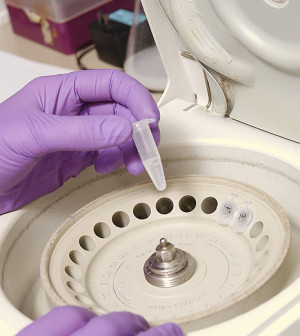- Navigating Your Midlife Crisis: Embracing New Possibilities
- City Raccoons Showing Signs of Domestication
- Mapping the Exposome: Science Broadens Focus to Environmental Disease Triggers
- One Week Less on Social Media Linked to Better Mental Health
- Your Brain Changes in Stages as You Age, Study Finds
- Some Suicide Victims Show No Typical Warning Signs, Study Finds
- ByHeart Formula Faces Lawsuits After Babies Sickened With Botulism
- Switch to Vegan Diet Could Cut Your Greenhouse Gas Emissions in Half
- Regular Bedtime Does Wonders for Blood Pressure
- Dining Alone Could Mean Worse Nutrition for Seniors
British Scientists Spot Brain’s Pain Center


British researchers say they’ve identified the area of the brain linked to pain intensity.
The University of Oxford team used a new imaging technique to observe how different levels of pain affected the brains of 17 volunteers. Activity in only one area of the brain — the dorsal posterior insula — matched the participants’ self-reported pain ratings.
This method could be used to help assess pain levels in people who have difficulty providing doctors with that information, such as those in a coma, small children or dementia patients, said the authors of the study published March 9 in the journal Nature Neuroscience.
“We have identified the brain area likely to be responsible for the core, ‘it hurts’, experience of pain,” researcher Irene Tracey said in a university news release.
“Pain is a complex, multidimensional experience, which causes activity in many brain regions involved with things like attention, feeling emotions such as fear, locating where the pain is, and so on. But the dorsal posterior insula seems to be specific to the actual ‘hurt level’ of pain itself,” she explained.
“We were able to find this area by developing a new method of tracking brain activity,” Tracey said. “This allowed us to look at more complex brain states that stretch over much longer periods. By tracking pain felt over many hours, we were able to filter out more momentary experiences, such as variations in attention or fear.”
In the study, 17 healthy volunteers had a cream containing capsaicin (the active ingredient in chili peppers) applied to their right leg, causing a burning sensation. When that pain began to subside, a hot water bottle was applied to the same area, to rekindle the pain. After a few minutes, a cool water bottle was placed on the area to relieve the pain.
While all this was being done, the participants’ brains were being scanned and they were telling the researchers about their levels of pain.
The results suggest that by changing activity in the dorsal posterior insula, it may be possible to ease pain that doesn’t respond to other treatments, the researchers said.
More information
The U.S. National Institute of Neurological Disorders and Stroke has more about pain.
Source: HealthDay
Copyright © 2025 HealthDay. All rights reserved.










